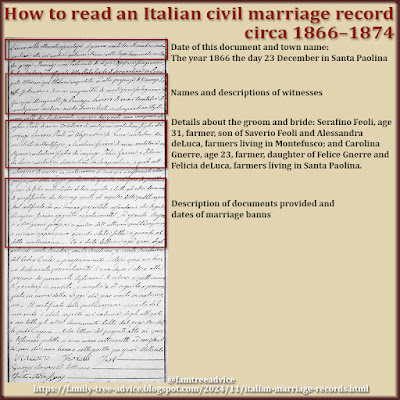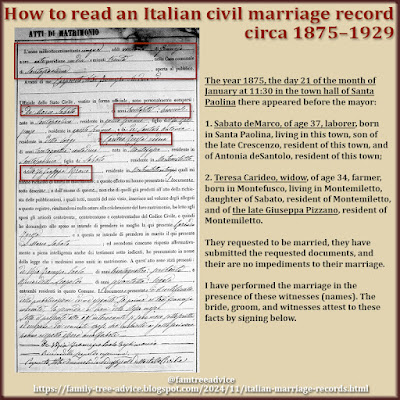 |
| 3 simple, worthwhile family tree tasks set you up for a new year of genealogy discoveries. |
It can be hard to find time for genealogy with the holiday season looming. But I'm sure you can find a moment here and there. And when you do, these 3 tasks are the perfect thing to accomplish before the year is through. Knock them off, and you'll be all set for bigger and better family tree achievements in the coming year.
1. See What's Missing
Review yourself and your direct ancestors (up through your second great grandparents) to see what's missing. Since these are some of the first people you entered into your family tree, it may be a long time since you've given them any attention.
- Have you found every available census record for them?
- Are there birth, marriage, or death records available that you couldn't find before? What about obituaries?
- Have you gathered the draft registration cards or military records for your men?
- If anyone from this group was an immigrant, have you found their ship manifest and naturalization papers?
A funny thing happened to me recently. I wanted to use the new LiveMemory™ feature from MyHeritage, but I had to do it through the phone app. (I had bad results, by the way. I still need to find a perfectly-lit, crisp photo to try. When I tried it on people I know very well, I hated the results.)
While I was using the app, I saw an unexpected hint for my Grandma Lucy's 1954 obituary. I couldn't access this particular Ohio newspaper with my free subscription, but I found it on Google News. There, for the first time, I saw Grandma Lucy's obituary, and I found her mother's obituary! I couldn't get her father's obit because that publication date was missing.
This proves how important it is to re-investigate your closest relatives.
2. Fix Errors Hiding in Plain Sight
Export a GEDCOM file from your family tree and open it in Family Tree Analyzer. This free program points out errors you can fix, including a mother who's too old to have that baby, someone who died before they got married, and "siblings" who were born too close together.
With your GEDCOM open in FTA, click the Errors/Fixes tab. Along the top of the window you'll see 32 types of errors, each with a checkbox. You can click the Select All button and then below that, click the little button with the downward arrow at the top of the Error Type column. Choose Sort A to Z. You may find that some of these errors should be excluded.
- Couples with same surnames. My people come from small towns where everybody shares a small number of surnames. This happens a lot. Removing this type of error brings my error total from 988 down to 584. (My family tree has 82,072 people!)
- Possible Duplicate Fact. My family tree has mostly Italian marriages where there are two recorded sets of marriage banns. That's not an error even if it looks like one. But I'm not going to uncheck this type of error because I see a few duplicate marriage facts. These must have happened when I realized I could merge people, and I overlooked the extra marriage fact. In other places I have duplicate residence facts. When I look at them in my family tree, one fact has a source citation, and the duplicate does not. These may be leftovers from a bad Ancestry sync I had a couple of years ago. I'm going to check these all out. If I did uncheck Possible Duplicate Fact, my error total would drop from 584 down to 59!
See what you can do to whittle down your error list. I know you'll be glad you did.
3. Check Locations
Use Family Tree Analyzer again to spot obvious typos in place names. Once you've opened your GEDCOM file in FTA, click the Main Lists tab to view the Individuals tab. Two columns in this list have place names: Birth Location and Death Location. One at a time, click the little button with a downward arrow beside the column name and choose Sort A to Z. Now all the place names are in alphabetical order. You may have lots of blanks at the top, as I do.
I must note that the Birth Location list will seem as if it's not entirely in alphabetical order. It turns out the locations are grouped by country, then state/province, then town, then street. So my United States locations are near the bottom of the list. My mother's Bronx New York, birth location is way, way down the list. Once you realize that, this task becomes easier.
Scan the list one screenful at a time and see what sticks out to you. If my list had 10 "Elmira, Chemung County, New York, United States" listings in a row, and then one "Elmyra, Chemung County, New York, United States", the mistaken "Elmyra" would stick out as being a typo. Make any necessary corrections to your family tree (wherever you build it), and then do the same with the Death Location list. First click that same little button with the downward arrow and choose Clear Sort, then sort the Death Location column A to Z.
Finally, switch from the Individuals tab to the Families tab. Scroll over to the Marriage Detail column which shows marriage dates and locations. Sort that column A to Z. This is a little less efficient, but still worth a look. The column is sorted by date, but the dates are treated like text. Because of that, my first non-blank rows are:
- 1 APR 1813 at Santa Paolina, Avellino, Campania Italy
- 1 APR 1824 at Chiesa del Santissimo Salvatore, Largo Chiesa Madre, 2, Pescolamazza, Benevento, Campania, Italy
- 1 APR 1824 at Chiesa di San Giorgio Martire, Via Gradoni San Giorgio, Colle Sannita, Benevento, Campania, Italy
This sorting method means that fewer of the same addresses will be grouped together. But it's the first time I'm seeing all my tree's marriage locations in one place, and that's still a good chance to proofread.
When you've done what you can on these 3 tasks, be sure to synchronize or republish your updated and scrubbed family tree. Come January, you're on to bigger and better genealogy research!
See what other magic you can do with Family Tree Analyzer:
Quick Note: I've never done this before, but there will be no new articles for the next two weeks. Hundreds of my past articles are always here for you.






